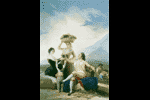|
Rococo
"The death of Louis XIV in 1715 brought
many changes in French high society. The court of
Versailles was at once abandoned for the pleasures of town life.
Although French citizens still owed their allegiance to a
monarch, the early eighteenth century saw a resurgence in
aristocratic social, political, and economic power.
Appropriately, some historians refer to the eighteenth century
as a great age of the aristocracy. The nobility not only
exercised their traditional privileges (for example, exemption
from certain taxes and from forced labor on public works) but
also sought to expand their power. This aristocratic
resurgence extended to dominance as art patrons. The
hotels (town houses) of Paris soon became the centers of a
new softer style called Rococo. The sparkling gaiety the
new age cultivated, associated with the regency that followed
the death of Louis XIV and with the reign of Louis XV, found
perfectly harmonious expression in this new style. Rococo
appeared in France in about 1700, primarily as a style of
interior design. The French Rococo exterior was most often
simple, or even plain, but Rococo exuberance took over the
interior. Rococo came from the French word
rocaille, which literally means "pebble," but the term
referred equally to the small stones and shells used to decorate
grotto interiors. Such shells or shell forms were the
principal motifs in Rococo ornament."
- Gardner's
Art Through The Ages,
11th edition, Vol. II, p. 780
|

The Harvest - Goya

Blindman's Bluff - Goya

La Maja - Goya

The family of Carlos IV - Goya

|
|
|
|